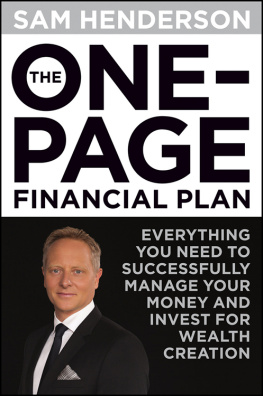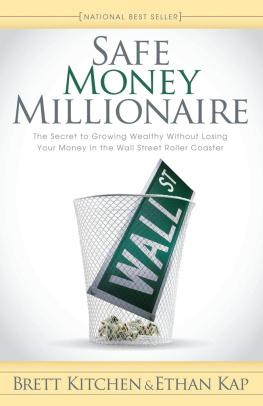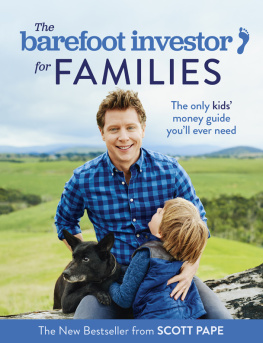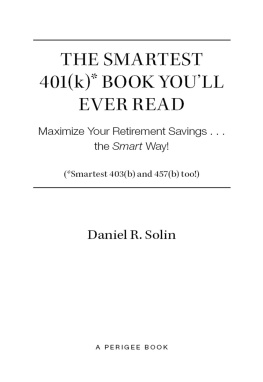Praise for RRSPs
Gordon Pape is one of Canadas most influential writers about investing and personal finance. This plain-speaking, step-by-step guide to RRSPs helps readers set up a plan, understand how they work, and build successful strategies to make this all-important source of retirement income grow and prosper over time.
Adam Mayers, investment and
personal-finance editor, Toronto Star
Financial sage Gordon Pape pulls no punches: an RRSP is your personal pension plan and should be managed accordingly. Learn how to do just that in this easy-to-read book, which describes the journey to peace of mind in retirement.
Evelyn Jacks, bestselling author of 50 tax-planning
books and president of Knowledge Bureau
All you need to know about RRSPs from Canadas ultimate wealth expert.
Rob Carrick, personal-finance
columnist, The Globe and Mail
Gordon Pape has merged tax planning, hard truths, important information, and sage advice to create a comprehensive view of an RRSP: before, during, and after the set-up of the plan. Anyone who reads the book carefully will have learned everything he or she will likely need to know at any stage of the RRSP.
Al Emid, financial-services author,
journalist, and broadcaster
Gordon Pape wants to banish the six words that can lead to financial ruin: I want to buy an RRSP. After reading this book, youll know how to make strategic investments in an RRSP (not purchases) and when to contribute to an RRSP compared to a tax-free savings account (TFSA). Youll find answers to all your questions here.
Ellen Roseman,
personal-finance and consumer columnist, Toronto Star, and author of Fight Back: 81 Ways to Help
You Save Money and Protect Yourself from
Corporate Trickery
Gordon Papes latest guide to RRSPs provides all of the detailed information that readers of his previous guides have come to expect, as well as lots of useful advice on how investors can best make use of these invaluable tax-deferred retirement plans. If you only buy one financial guide this RRSP season, this should be the one.
Gavin Graham,
chief strategy officer, INTEGRIS Pension Management
PORTFOLIO PENGUIN
RRSPs
GORDON PAPE is Canadas best-known financial author and the publisher of two investment newsletters: The Income Investor and the Internet Wealth Builder. He is the author/ co-author of several national bestsellers, including Tax-Free Savings Accounts, Retirements Harsh New Realities, Money Savvy Kids, and Sleep-Easy Investing. He has spoken at hundreds of seminars in Canada and the United States, is frequently quoted in the media, and is a popular guest on radio and television shows. His website is located at www.BuildingWealth.ca.
Also by Gordon Pape
INVESTMENT ADVICE
Tax-Free Savings Accounts | Secrets of Successful Investing |
Money Savvy Kids | (with Eric Kirzner) |
(with Deborah Kerbel) | Gordon Papes Investing Strategies 2001 |
Retirements Harsh New Realities | (with Richard Croft and Eric Kirzner) |
The Ultimate TFSA Guide | Making Money in Mutual Funds |
Sleep-Easy Investing | The Canadian Mortgage Book |
The Retirement Time Bomb | (with Bruce McDougall) |
Get Control of Your Money | The Best of Papes Notes |
6 Steps to $1 Million | Head Start (with Frank Jones) |
Retiring Wealthy in the 21st Century | Retiring Wealthy |
The Complete Guide to RRIFs and LIFs | Building Wealth in the 90s |
(with David Tafler) | Low-Risk Investing in the 90s |
Gordon Papes 2004 Buyers Guide to | Low-Risk Investing |
Mutual Funds (with Eric Kirzner) | Building Wealth |
Gordon Papes 2004 Buyers Guide |
to RRSPs |
CONSUMER ADVICE
Gordon Papes International Shopping Advice (with Deborah Kerbel)
HUMOUR
The $50,000 Stove Handle
CHRISTMAS (with Deborah Kerbel)
Quizmas Carols
Family Quizmas
Quizmas: Christmas Trivia Family Fun
FICTION (with Tony Aspler)
Chain Reaction
The Scorpion Sanction
The Music Wars
NON-FICTION
Montreal at the Crossroads (with Donna Gabeline and Dane Lanken)
RRSPs
The Ultimate Wealth Builder
Gordon Pape

To the memory of my beloved wife, Shirley Ann Pape. I miss you.
A Look Back
Registered Retirement Savings Plans (RRSPs) have been around longer than most of todays Canadians. Pushing through the legislation creating them was one of the final acts of the Liberal government of Louis St. Laurent back in 1957. But the Liberals were gone from office, replaced by the Progressive Conservative government of John Diefenbaker, by the time the plans were officially launched the following year.
Giving Canadians a tax incentive to save for their own retirement was considered a radical idea at the time, but it made a lot of sense. The Canada and Quebec pension plans were still a decade down the road. The only income support for retirees without a workplace pension plan was Old Age Security. Clearly, something more was needed.
Few people realized the importance of the plan at the time. In fact, it was not even the centrepiece of the March budget introduced by the finance minister of the day, Walter Harris. With the Liberals knowing they were in trouble in the upcoming election, his focus was on the removal of an unpopular 10 percent tax on candy, gum, and soft drinks. Predictably, thats what grabbed the headlines. The RRSP news was relegated to page two.
The candy tax story has long since faded into oblivion. But RRSPs are still around all these years later and are arguably even more important today with the steady decline in the number of employees who have a workplace pension plan.
Of course, there have been many tweaks to the system over time, some good, some questionable. Among those in the good category, the steady increase in contribution room ranks at the top of the list. When RRSPs were launched, the most people were allowed to contribute each year was 10 percent of earned income to a maximum of $2500. By 2014, the limit had increased to 18 percent of the previous years earned income to a maximum of $24,270.
Another huge improvement was the decision to allow unlimited carry-forwards for unused contribution room. Prior to 1991, it was a case of use it or lose it. If you didnt have the money to make a contribution in any given year, too bad. It was gone forever. That finally changed in 1991, but there was a time limit of seven years for making up unused contributions. That restriction was removed by Liberal finance minister Paul Martin in his 1996 budget, and since then unlimited carry-forwards have been permitted.
Originally, people could contribute to RRSPs until age 71. That changed in 1997 when the age limit was reduced to 69 as part of the federal governments austerity program to eliminate the high deficit that was threatening the countrys credit rating. The Conservatives restored it to age 71 in the 2007 budget; now there is growing demand to have it bumped up again, with 73 being the age most often mentioned. The rationale is that since people are living longer, they should be allowed more time to save.
Next page












